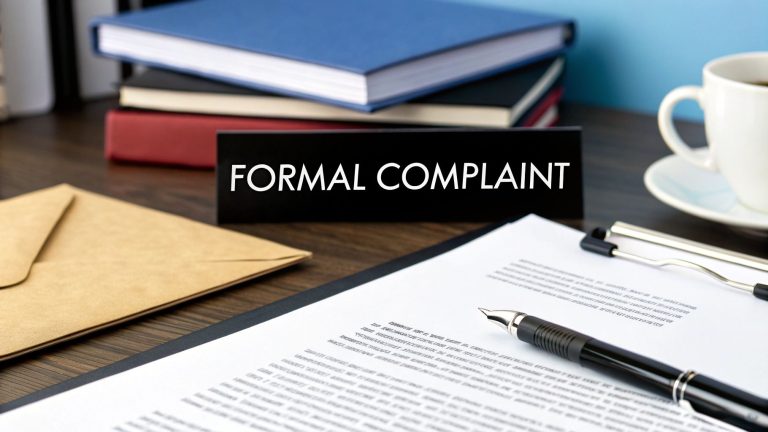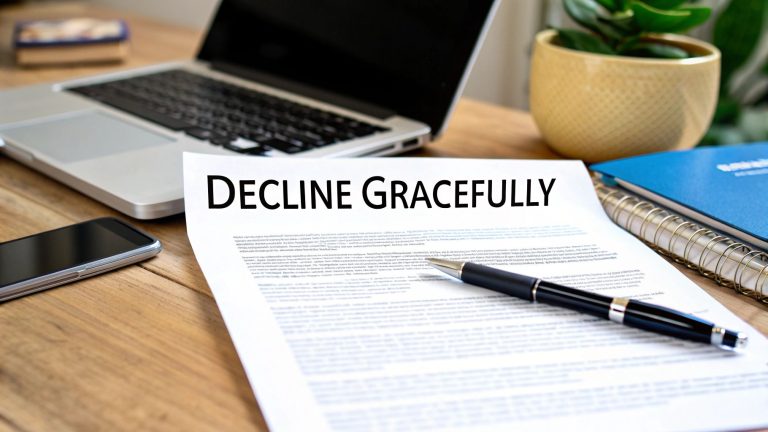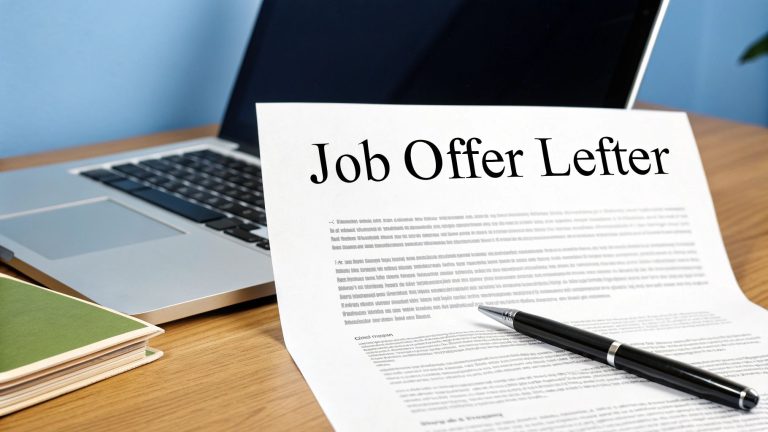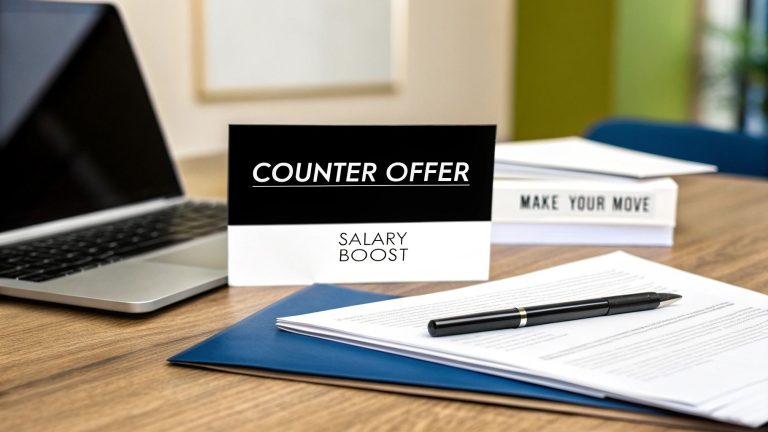The interview isn't over when you leave the room. The email you send afterward is a critical final impression that can reinforce your value, address lingering questions, and keep you top-of-mind with hiring managers. While a simple 'thank you' is standard, a strategically crafted message can be the deciding factor in a competitive hiring process. A powerful email after interview sample does more than show courtesy; it demonstrates proactiveness, attention to detail, and continued enthusiasm for the role.
In this guide, we break down six essential types of post-interview emails. We move beyond basic templates to provide in-depth analysis and actionable strategies for each scenario. We'll explore everything from the classic thank-you note to the nuanced clarification email, providing samples, strategic breakdowns, and expert tips to help you communicate with confidence and professionalism.
Whether you're following up on a phone screen or a final-round panel, these examples will equip you to make every word count. We’ll show you how to tailor each message to your specific situation, ensuring your follow-up reinforces why you are the best candidate. This collection of samples will help you secure your next role.
1. Standard Thank You Email
The standard thank you email is the cornerstone of post-interview communication. It’s a professional, straightforward message sent within 24 hours of your interview to express gratitude, reiterate your interest, and briefly reinforce why you are a great fit for the role. This isn't just a courtesy; it's a strategic move that keeps you top-of-mind with the hiring manager and demonstrates your professionalism and follow-through.

This classic approach is a non-negotiable step for nearly every job application process. Top-tier organizations, from tech giants like Google to consulting firms like McKinsey & Company, expect and often recommend this format. It’s a clean, effective way to close the loop on your interview and leave a lasting positive impression.
Example: Standard Thank You Email
Subject: Thank you – Interview for [Job Title]
Dear [Interviewer's Name],
Thank you so much for taking the time to speak with me today about the [Job Title] position. I truly enjoyed our conversation and learning more about the team's work on [Specific Project or Initiative], as well as the company culture at [Company Name].
Our discussion about [Specific Topic from Interview] was particularly insightful, and it reinforced my enthusiasm for this opportunity. My experience in [Your Relevant Skill or Experience] aligns well with the challenges you described, and I am confident I can contribute to your team's goals.
I am very excited about the possibility of joining your team and look forward to hearing about the next steps. Please feel free to contact me if you need any additional information.
Best regards,
[Your Name]
Strategic Breakdown
- Promptness and Professionalism: Sending this email within 24 hours shows you are organized, proactive, and genuinely interested. Waiting too long can diminish its impact.
- Personalization is Key: The line, "Our discussion about [Specific Topic from Interview] was particularly insightful," is the most critical part. It proves you were actively listening and moves the email from a generic template to a meaningful, personal follow-up.
- Reinforces Your Value: The sentence connecting your experience to their needs ("My experience in [Your Relevant Skill or Experience] aligns well…") is a subtle but powerful reminder of your qualifications without being overly aggressive.
- Clear Call to Action: The closing clearly states your excitement and anticipation for the "next steps," guiding the hiring manager on how the conversation should proceed.
Actionable Takeaways
- Time it Right: Send your email the same day or the following morning. Avoid sending it immediately after walking out of the interview, as it can seem rushed or automated.
- Jot Down Notes: Immediately after your interview, write down 2-3 specific, unique points from the conversation. This will be the foundation for personalizing your thank you note.
- Proofread Meticulously: A simple typo or grammatical error can undermine the professional image you're trying to project. Read it aloud or use a tool to check for mistakes.
- Keep it Concise: Your goal is to be memorable, not to overwhelm. Stick to a three-paragraph structure: express thanks, connect with a specific point, and reiterate interest. For more guidance on maintaining a professional tone, discover these tips for professional letter writing.
2. Value-Add Follow-Up Email
The value-add follow-up is an advanced version of the standard thank you note. It elevates your message from a simple expression of gratitude to a demonstration of your proactive problem-solving abilities. Instead of just reiterating interest, you provide tangible value, such as a relevant article, a small work sample, or a brief solution to a problem discussed in the interview. This email after interview sample shows you’re not just a candidate; you’re a contributor from day one.

This strategic approach is highly effective in competitive fields like technology, consulting, and marketing. Companies like Bain & Company and innovative tech startups appreciate candidates who think beyond the interview questions and demonstrate a genuine passion for solving their specific challenges. It’s a powerful way to differentiate yourself and prove your commitment.
Example: Value-Add Follow-Up Email
Subject: Following up – Interview for [Job Title]
Dear [Interviewer's Name],
Thank you again for your time yesterday. I genuinely enjoyed our conversation about the [Job Title] role and was particularly interested in our discussion about the challenge of [Specific Challenge Discussed, e.g., increasing user engagement].
It got me thinking, and I remembered a case study about how a similar company tackled this by [Brief, one-sentence solution]. I've attached it for you in case it's a useful reference. My experience in [Your Relevant Skill, e.g., A/B testing user flows] could be directly applied to implementing a similar strategy at [Company Name].
I am even more excited about this opportunity after our discussion. I look forward to hearing about the next steps and am happy to provide any further information.
Best regards,
[Your Name]
Strategic Breakdown
- Goes Beyond Thanks: The email's core purpose is to provide value, not just thanks. It positions you as a thoughtful problem-solver who is already invested in the company's success.
- Demonstrates Proactive Thinking: Mentioning "It got me thinking" shows that you didn't just forget the conversation after you left. It proves you are actively considering their challenges and are eager to contribute solutions.
- Highly Relevant Content: The attached resource isn't random; it directly addresses a pain point ("the challenge of…") raised during the interview, making it immediately useful and impressive.
- Connects Value to Your Skills: The email skillfully pivots from the shared resource back to your qualifications ("My experience in… could be directly applied"), reinforcing why you are the right person for the job.
Actionable Takeaways
- Relevance is Everything: Only send additional material if it is highly relevant and genuinely helpful. A generic article will have the opposite effect. The goal is to solve, not to spam.
- Keep it Concise: The value-add should be a supplement, not the main event. Your email should still be short and easy to read. Let the attachment or link provide the deeper detail.
- Frame it as a Helpful Suggestion: Present the information humbly, as in, "in case it's a useful reference." This avoids coming across as arrogant or as if you have all the answers.
- Ensure Professional Presentation: The content you share reflects on you. Whether it's a portfolio link or a document, make sure it is polished and professional. For more on structuring professional correspondence, review this guide on how to format a letter.
3. Panel Interview Thank You Email
Navigating a panel interview requires a special touch, and so does the follow-up. A panel interview thank you email is a strategic approach for thanking multiple interviewers. Instead of sending one generic group email, you send individually personalized notes to each panel member, demonstrating a high level of attention to detail and respect for their unique contributions to the conversation.
This method is crucial in environments where consensus is key to hiring. It's common practice in Fortune 500 companies, academic institutions, and healthcare organizations where leadership roles are filled by committee. By addressing each person individually, you acknowledge their specific role and perspective, making a far stronger impression than a single, one-size-fits-all email.
The infographic below outlines a simple yet effective process for managing this type of follow-up.

This process ensures that each interviewer receives a thoughtful, personalized message without appearing automated or insincere.
Example: Panel Interview Thank You Email
Subject: Thank you – Following up on our [Job Title] discussion
Dear [Interviewer's Name],
Thank you again for your time during the panel interview for the [Job Title] position this morning. I particularly enjoyed our discussion about [Specific Topic You Discussed with This Person]. Your insights on [Mention a Specific Point They Made] were especially valuable.
The conversation solidified my interest in joining [Company Name] and contributing to the team's success. My background in [Your Relevant Skill] feels like a strong match for the challenges you outlined, and I am excited by the prospect of bringing my experience to your innovative projects.
I look forward to hearing about the next steps in the hiring process. Thank you once more for a great conversation.
Best regards,
[Your Name]
Strategic Breakdown
- Individual Recognition: The core strategy is personalization. Mentioning a specific point from your one-on-one exchange with that interviewer ("Your insights on…") shows you weren't just a passive listener but an engaged participant.
- Consistent Core Message: While the personal detail changes for each email, the core message of enthusiasm, value proposition ("My background in…"), and next steps remains consistent, ensuring a unified message.
- Demonstrates High EQ: This approach shows high emotional intelligence and social awareness. You recognize that each panelist has a unique stake and voice in the hiring decision, and you respect that by addressing them as individuals.
- Staggered Sending: Sending individual emails at slightly different times (e.g., 15-20 minutes apart) makes the outreach feel more natural and less like a mass-produced template.
Actionable Takeaways
- Collect Business Cards: If possible, collect a business card from each panelist or make a note of their full name and title to ensure accuracy. If you don't have their emails, send them to the main HR contact and ask them to forward the notes.
- Focus on Unique Interactions: For each email, recall a specific question they asked you or a unique point they made. This personal connection is what makes the strategy effective.
- Maintain a Consistent Tone: Ensure your level of enthusiasm and the core reasons for your interest are the same across all emails to avoid sending mixed signals.
- Proofread Every Email Separately: Double-check the spelling of each person's name and title. A small mistake can undermine the effort you put into personalization.
4. Interview Correction/Clarification Email
The Interview Correction/Clarification Email is a specialized follow-up used when you realize you made a significant error or provided an unclear answer during your conversation. This email demonstrates self-awareness, accountability, and a high level of professionalism. Instead of hoping the mistake goes unnoticed, you proactively address it, turning a potential weakness into a display of your commitment to accuracy and detail.

This tactic is particularly valuable in technical fields where precision is paramount. For instance, in the demanding interview processes at tech companies like Amazon or in high-stakes investment banking interviews, correcting a flawed coding solution or an inaccurate financial calculation can reinforce your problem-solving skills and honesty. It shows you continue to think about the challenges presented even after the interview has concluded.
Example: Interview Correction/Clarification Email
Subject: Following up on our interview for [Job Title]
Dear [Interviewer's Name],
Thank you again for your time today. I truly enjoyed our conversation about the [Job Title] role and the challenges your team is tackling at [Company Name].
After reflecting on our discussion, I realized I may not have clearly articulated my response to your question about [Specific Interview Question]. To clarify, when we discussed the best approach for [Technical Problem or Scenario], I initially suggested [Your Original, Flawed Answer].
Upon further thought, a more efficient solution would be [Your Corrected/Improved Answer], because it [Briefly Explain Why It's Better, e.g., "reduces server load by X%" or "provides a more scalable framework"]. I wanted to provide this additional context as I'm passionate about finding the most effective solutions.
I remain very enthusiastic about this opportunity and look forward to hearing from you.
Best regards,
[Your Name]
Strategic Breakdown
- Timely and Confident: This email should be sent shortly after the standard thank-you note, while the conversation is still fresh. The tone is confident and constructive, not apologetic or self-deprecating.
- Focus on a Specific Error: It pinpoints the exact question and answer that needed correction ("when we discussed the best approach for…"). This directness avoids confusion and shows you have a clear memory of the interview.
- Provides a Superior Solution: The core of the email is not just pointing out a mistake but offering a better, well-reasoned alternative. The "because" statement is crucial, as it demonstrates the analytical thinking behind your revised answer.
- Reinforces Positive Qualities: By sending this, you showcase valuable traits like critical thinking, intellectual honesty, and a dedication to quality work, which are highly sought after by employers.
Actionable Takeaways
- Correct Only Significant Errors: Do not use this for minor stumbles or slightly imperfect phrasing. Reserve it for factual inaccuracies or substantially better solutions that could impact the hiring decision.
- Integrate with a Thank You: You can combine this with your standard thank-you email or send it as a separate, focused follow-up. If you send it separately, keep it brief and to the point.
- Frame it as a Clarification: Use language like "upon further reflection" or "to clarify my thoughts" rather than "I made a mistake." This frames the action positively.
- Be Direct and Concise: State the issue, provide the correction, explain the benefit, and conclude. Over-explaining can make you seem insecure. Mastering this balance is a key part of professional correspondence, and you can explore more about letter writing etiquette.
5. Second Follow-Up Email
The second follow-up email is a delicate but often necessary tool in a prolonged hiring process. Sent 1-2 weeks after your initial thank you note if you haven't heard back, this message serves as a polite nudge. It reaffirms your strong interest in the role without appearing impatient, demonstrating persistence and professional courtesy.
This type of email is particularly useful in situations where hiring timelines are long or unpredictable. This includes large corporations with complex internal processes, government roles known for bureaucratic delays, or even fast-moving startups where priorities can shift unexpectedly. Sending a well-crafted second follow-up can bring your application back to the top of the pile and show you're still engaged and eager.
Example: Second Follow-Up Email
Subject: Following up – [Job Title] Interview
Dear [Interviewer's Name or Hiring Manager's Name],
I hope this email finds you well.
I'm writing to follow up on my interview for the [Job Title] position on [Date of Interview]. I'm still very interested in the opportunity to join [Company Name] and contribute to your team. I was particularly excited about [Mention a specific project or aspect of the role] we discussed.
I understand that you are likely very busy, but I was hoping you might be able to provide a brief update on the hiring timeline.
Thank you again for your time and consideration. I look forward to hearing from you.
Best regards,
[Your Name]
Strategic Breakdown
- Polite and Patient Tone: The opening "I hope this email finds you well" and the acknowledgment "I understand that you are likely very busy" set a respectful and understanding tone. This prevents the email from sounding demanding.
- Contextual Reminder: Mentioning the specific job title and the date of your interview immediately helps the recipient recall who you are and which position you are inquiring about.
- Reiteration of Enthusiasm: Briefly restating your interest and referencing a specific part of the conversation ("I was particularly excited about…") reinforces your genuine enthusiasm for this specific role, not just any job.
- Direct but Gentle Ask: The question "I was hoping you might be able to provide a brief update" is a soft, non-confrontational way to ask for information about the next steps.
Actionable Takeaways
- Respect the Timeline: Only send this email after the timeline provided by the interviewer has passed. If no timeline was given, wait at least a week or two after your initial thank you note.
- Keep it Brief and Professional: This is not the place to restate your entire resume. The goal is a quick, professional check-in. Keep the message concise and focused on your continued interest and request for an update.
- Send it to the Right Person: Address the email to the hiring manager or your main point of contact in the hiring process. If you interviewed with multiple people, choose the one who seemed to be leading the process.
- Know When to Stop: In most cases, this should be your final follow-up. Sending more emails can come across as desperate or annoying. After this point, it's best to focus your energy on other opportunities.
6. Phone Interview Thank You Email
A phone or video interview lacks the non-verbal cues and personal connection of an in-person meeting, making your follow-up email even more crucial. This specialized thank you note is designed to bridge that gap, working harder to build rapport and reinforce the conversation's key moments. It's an essential tool to make a memorable impression when your interaction has been entirely remote.
This email after interview sample is standard practice for remote-first companies like GitLab and Buffer, where phone and video screens are the norm. It's also heavily used by executive search firms and global corporations that conduct initial interviews across different time zones. The goal is to solidify your presence and personality in the interviewer's mind, ensuring you stand out from other voices on the phone.
Example: Phone Interview Thank You Email
Subject: Thank you – Phone Interview for [Job Title]
Dear [Interviewer's Name],
Thank you again for your time this morning. I sincerely enjoyed our phone conversation about the [Job Title] role and learning more about how [Company Name] is tackling [Specific Industry Challenge].
I found our discussion about [Specific Topic, e.g., your approach to user-led design] particularly engaging. It was great to hear your perspective, and it confirmed my belief that my experience in [Relevant Skill, e.g., agile development and rapid prototyping] would be a strong asset to your team. As promised, here is the link to the [Portfolio/Project] I mentioned: [Link].
I am very enthusiastic about the opportunity to contribute to your team and look forward to hearing about the next steps in the process.
Best regards,
[Your Name]
Strategic Breakdown
- Compensates for Lack of Presence: Unlike an in-person meeting, a phone call can be less memorable. This email's specificity serves to anchor your conversation and your candidacy in the interviewer's memory.
- Builds on the Conversation: Mentioning a specific topic and following up with a promised link ("As promised, here is the link…") shows you are reliable and proactive, turning a simple thank you into a value-add interaction.
- Demonstrates Active Listening: Referencing a specific part of the conversation proves you weren't just passively answering questions. It shows you were engaged, processing the information, and thinking critically about the role.
- Reiterates Technical Fit: The email subtly reinforces your qualifications by connecting a specific part of the discussion directly to one of your key skills, solidifying your fit for the role.
Actionable Takeaways
- Take Detailed Notes: During the call, scribble down keywords, specific project names, and unique questions the interviewer asked. These notes are your raw material for a powerful, personalized follow-up.
- Reference Specific Dialogue: Don’t just say "I enjoyed our conversation." Say, "I particularly enjoyed our discussion about the new data analytics platform." This precision makes your email unique and memorable.
- Follow Up on Promises: If you offered to send a portfolio, article, or another piece of information during the call, your thank you email is the perfect place to do it. This demonstrates exceptional follow-through.
- Keep it Sharp and Focused: A phone interview thank you should be concise and to the point. Aim for a clear, three-paragraph structure that expresses gratitude, adds value, and confirms your interest. To help craft the perfect message, you can find a free thank you letter generator on lettergenerator.co.
6 Types of Post-Interview Email Comparison
| Email Type | Implementation Complexity | Resource Requirements | Expected Outcomes | Ideal Use Cases | Key Advantages |
|---|---|---|---|---|---|
| Standard Thank You Email | Low – straightforward template | Minimal – basic personalization | Increases callback rates by 15-20% | Most interviews; general professional roles | Demonstrates professionalism; courteous follow-up |
| Value-Add Follow-Up Email | Medium – requires research | Moderate – time to gather relevant content | Differentiates candidate; shows expertise | Senior, creative, consulting, technical roles | Shows initiative and thought leadership |
| Panel Interview Thank You Email | High – customized for multiple interviewers | High – individual personalization and timing | Improves feedback from multiple interviewers | Panel interviews in corporate, academic, healthcare | Shows respect and organizational skills |
| Interview Correction Email | Medium – careful wording needed | Moderate – timely and confident response | Turns mistakes into positive impressions | Technical, finance, consulting roles | Demonstrates accountability and accuracy |
| Second Follow-Up Email | Low – polite and concise | Minimal – follow-up after initial contact | Increases response rates by 10-15% | Lengthy hiring processes; delayed responses | Maintains candidacy and professional persistence |
| Phone Interview Thank You Email | Medium – detail recall without visuals | Moderate – note-taking and specific references | Reinforces remote connection and professionalism | Remote, phone or video interviews | Builds rapport despite lack of visual cues |
From Sample to Signature: Mastering Your Post-Interview Strategy
Throughout this guide, we've explored a range of scenarios and provided a versatile toolkit of post-interview email samples. Moving beyond simple templates is the key to making a lasting impression. Each email after interview sample we've dissected serves not as a rigid script, but as a strategic foundation upon which you can build a personal and impactful message.
The core lesson is this: your follow-up is not just a courtesy. It is a critical extension of the interview itself, offering one final opportunity to demonstrate your communication skills, reinforce your value, and express genuine enthusiasm for the role.
Key Takeaways for Your Post-Interview Communication
To transform these samples into your signature approach, always prioritize these three strategic pillars:
-
Personalization is Paramount: Never send a generic, copy-and-paste message. Reference specific points from your conversation, mention a project you discussed, or connect your skills to a particular challenge the interviewer shared. This proves you were engaged and are already thinking about how you can contribute.
-
Add, Don't Just Ask: Your goal is to be memorable for the right reasons. Instead of simply asking for an update, find ways to add value. Share a relevant article, offer a brief solution to a problem discussed, or provide a portfolio link you forgot to mention. This proactive approach reinforces your expertise and dedication.
-
Timing and Tone are Everything: The best messages are sent promptly (within 24 hours), are meticulously proofread, and strike a perfect balance between professionalism and warmth. Be confident but not arrogant, persistent but not pushy. Your tone should mirror the company's culture and the rapport you built during the interview.
Your Actionable Next Steps
Mastering the follow-up email is a crucial step, but it's part of a larger professional branding strategy. While the hiring manager reviews your message, they will almost certainly revisit your online presence. Ensuring every touchpoint is polished and professional is non-negotiable. This is an ideal time to learn how to perfect your professional LinkedIn profile picture, as it is often the first visual impression you make.
By internalizing the strategies behind each email after interview sample, you equip yourself to handle any post-interview scenario with confidence and poise. You move from a candidate who just checks the boxes to one who actively shapes the hiring manager's perception. This thoughtful, strategic communication is what separates a good candidate from the one who gets the offer.
Feeling the pressure to write the perfect follow-up? The AI Letter Generator can help you craft a polished and personalized email in minutes, ensuring your message hits all the right notes. Transform our samples into your success story with the power of AI. Try the AI Letter Generator today





